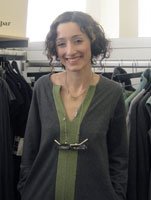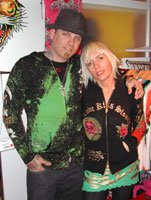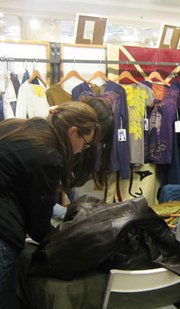Cautious Buying at Fall '08 L.A. Market
Buyers were cautious with their spending, and most exhibitors reported lighter-than-usual traffic at the March 14–18 run of the Los Angeles Fashion Market.
The news came as little surprise after months of negative reports about a slowing economy, high gas prices and trailing retail sales. But some exhibitors were pleasantly surprised by the business done at market.
“I was fearful going into the market,” said showroom owner Liza Stewart. “But everyone showed up for the party.”
Stewart estimated that sales at her Liza Stewart Showroom in the California Market Center increased 15 percent over last Fall.
To be sure, buyers had plenty to choose from and plenty of venues to shop, including wholesale showrooms in the CMC, The New Mart, the Cooper Design Space, the Gerry Building and The Lady Liberty Building.
There were also contemporary resources showing at Designers and Agents and Brighte Companies, lingerie labels showing at Boutique Lingerie, shoe brands showing at Transit at the CMC and Korean apparel manufacturers showing at Global Korea Fashion Week L.A. 2008 in the CMC’s Exhibit Hall.
Showroom owners in the CMC reported good— but not stellar—business at what the CMC calls the L.A. Fashion, Gift & Home Market.
“We did our regular business,” said Michael Gae, who co-owns the 22-year-old Rep etTrois showroom. “What was missing was the national attendance we usually get—the Florida, the New Jersey and the Chicago customers.” Gae estimated traffic was down 20 percent from the previous Fall market.
Retailers Barneys New York, Electric Ladyland, Dillard’s, Hot Topic, Metropark, Madison, Kitson, Macy’s West, Blue Bee, Fred Segal, Saks Fifth Avenue, Neiman Marcus and Diane Merrick shopped the market, according to a prepared statement from the CMC. Attendance was up at market from the previous year, the CMC said, but building officials didn’t release firm numbers or percentage increases.
Diane Merrick, who owns her namesake boutique in Los Angeles, said she bought more conservatively this market, an estimated 10 percent less compared with the previous market. She said that the weak economy and the 2007 Hollywood writers’ strike cut into her clients’ discretionary income. The economic changes have guided her buying choices. “I want to buy close to the market. I want to buy clothes that I know are going to sell,” she said.
Merrick said she did not see any new Fall trends for this market. Skinny jeans, a 2007 trend, continue to be big sellers at her shop. Nina Messiah, who co-owns her self-named men’s and women’s boutique in Beverly Hills, also said there were few must-have women’s trends to pick up at market. However, she noted that organic T-shirts are popular for women, and outerwear such as peacoats and track jackets have been popular for men.
Still buying at The New Mart
Traffic declined 20 percent at the New Mart. Ethan Eller, the building’s general manager, blamed the slow traffic on a weak economy. “Stores are doing what they can to reduce inventory levels as a hedge against a slowdown,” he said. The building registered 1,013 buyers for the recent market, compared with 1,249 the same time in the previous year.
While traffic was down, showroom owners said there was still good business. A weak dollar attracted more business from overseas, according to Steeve Bohbot, owner of Connected InternationalSales, a streetwear and fashion showroom. His lines include Clean Laundry by English Laundry and Joy Rich.
“International buyers made the whole show,” Bohbot said. He estimated that 70 percent of his market business was from buyers from Japan, England, Germany and Russia. Bohbot’s overseas clients wrote orders for the Fall season. His California clients were interested in making orders for Immediate deliveries, starting with dates of July 15.
Other showrooms did business almost entirely with domestic boutiques. Showroom owner Marilyn Rodriguez made appointments with well-established retailers, including New York– based Scoop and LosAngeles–based Satine. “All of our appointments showed up, but we saw less of the smaller stores,” Rodriguez said. She owns The Room, which carries contemporary lines including Rhys Dwfen and Kelly Nishimoto.
New showrooms, majors at Cooper
“Showrooms told me they saw all the majors and more Japanese than previously,” said Mona Sangkala, the Cooper Design Space’s leasing manager, noting that there seemed to be a drop in specialty-store attendance. Still, she said, showrooms started getting busy as early as March 10.
Many showrooms reported sluggish business and cautious buying. Chris Adams of the Victims of Success showroom, a menswear showroom, said part of the slowness might be due in part to the Class show, which debuted in Santa Monica, Calif., earlier in March. “Buyers might have gone there,” he said. Still, he said, orders were written at market.
“From our indications, even in a recessionary economy, we had a pretty-busy market,” said Tony Graham, co-partner of the Findings Showroom. Graham noted that moving the market dates earlier and holding it immediately after the Los Angeles FashionWeek shows was particularly helpful. This season, the Los Angeles Fashion Week followed one week after the Feb. 24–March 2 run of Paris Fashion Week.
“Having it so soon after Paris fashion week—before it used to be one month later— helps us to still be part of the buzz and momentum,” Graham said. “Buyers that are in Paris can more easily come to Los Angeles, and many European stores did. We saw a lot of Japanese buyers. Coordinating fashion week and market week [back-to-back] consolidated the buyers.”
Alex Rotundo of the Standard showroom, which bowed in its new space on the fifth floor, greeted the market with a new menswear-only focus. “It was slow, and it feels very late in the season, but the key players came,” he said. Buys were earned, unexpectedly, not by price-right staples such as T-shirts but by statement pieces.
And despite the slowing economy, the Cooper building welcomed buyers with a handful of new showrooms, including Development, Simon, Clarity and the Nikki and Lucy Showroom. Helmut Lang opened a pop-up showroom on the building’s mezzanine level for the market.The building also saw the market debut of the Joanne Fiske Showroom, the first showroom to open on the Cooper’s 10th floor. The remainder of the floor has been leased out and construction is brisk. The showroom, which moved from The New Mart, added several lines to its roster, including tank line Wilted, T Luxury, sweater and scarf line Covered, and Twenty8Twelve, a contemporary collection.
Buyers discovering Lady Liberty
The Lady Liberty Building has been open for a little more than one year, but it may have finally registered on buyers’ radar screens, according to Eric M. Martin, partner in the building’s showroom The Park.
More than 100 buyers stopped by his showroom to shop lines such as Scotch & Soda and Trunk LTD. Retailers included Ron Robinson at Fred Segal, Nordstrom and Neiman Marcus. The attendance marked a big difference from the same market in 2007. “The only buyers who stopped by were the appointments, and many of them got lost,” Martin said. The Lady Liberty Building is located at 843 S. Los Angeles St., less than one block north of the California Market Center.
The weak economy affected buyers, Martin said, but they did write orders. “Everyone stayed in their budgets,” he said.
Handful of business at the Gerry
Traffic at the Gerry Building was sparse, but reps such as Yvonne Collazo of Fornarina did manage to see a “handful of buyers,” she said.
Buyers were browsing the Italian label’s red wool-blend coats, striped sweaters with plunging V-necks, polka-dot skirts and retro leather jackets.
“The buyers liked our colors because they weren’t too bright,” Collazo said.
The Gerry Building has experienced a number of vacancies because the building’s owner, LaeRoc, is converting it into for-sale space and several tenants chose not to buy.
Casual versatility at D&A
Held March 14–16 in temporary spaces at the Cooper Design Space and The New Mart buildings, Designers and Agents saw buyers take an interest in classic styles that would stand the test of time.
“Right now, the end buyer is looking for versatile, well-made pieces,” said Brooklynbased designer Bahar Shahpar. “They’re not as willing to be splurging on ’wear it once’ pieces. They want fashion that is longlasting and that is stylish and quality,” To that end, Shahpar, who said she is known for her whimsical and tailored designs in her self-named line, focused on using more casual fabrics but kept her clean lines and quirky design details. Dresses and blouses in silk linen double weave, heavy silk crepe, silk jersey, silk voile and an organic cotton/ wool crepe featured crisp shapes, pin-tucking and key hole details for Fall.
Puella, a Los Angeles–based contemporary tops and dresses lines, also saw clients focus on its more-casual offerings. “It is an easier price point, but also, casual pieces are easier to work into your wardrobe,” said Elena Doukas, a sales rep for the line. Hoodies and jackets in super-soft fabrics and easy-to-wear tops earned strong buys from buyers for Fall.
Touche Luxe, a collection from Paris, brought both glittery party dresses and more-casual knits to D&A. “The more-casual pieces did best. California is more casual to begin with, but there was also some pricepoint fear,” said the brand’s sales rep. Knits, wholesaling between $80 and $120, easily outstripped cocktail dresses and pretty tops that started at $180.
In response to the slowing economy and more cautious buying, the Fall edition of D&A was smaller than usual. Co-organizer Barbara Kramer said D&A, which usually occupies two floors at the Cooper building, “decided to tighten up” its roster. “The California market is still feeling the effects of people’s concern with the economy,” Kramer said. “The show was well-received, and there was excitement in terms of our presentation, but there is definitely a sense of buyers being very cautious.”
Bright spots at Brighte show
Traffic fluctuated through the run of the Brighte Companies show, held March 14–17 in the CMC’s Fashion Theater and annex.
The show saw an influx of first-time exhibitors looking to gain more exposure on the West Coast. Among them was Portland, Maine–based shirtmaker Jill McGowan, who showed Egyptian-cotton tops made from Italian and Swiss textiles.
“I met a lot of stores from the Northwest that I rarely see in New York. I picked up five new accounts with five more potential accounts,” McGowan said.
Dealing with European fabrics has forced the company to take a hit on currency exchanges, McGowan said. “We actually had growth last year but were hit by the dollar’s [weakening in Europe].
Another first-time Brighte exhibitor was New York’s An Ren, who showed her rich, textured jackets to the West Coast for the first time. Ren, who has an East Village store in New York, only sells wholesale at trade shows such as Brighte. West Coast buyers such as Angel Throop of the Angels Everywhere boutique in Sierra Madre, Calif., were scoping the broad selection of Ren’s unique outerwear, priced between $150 and $250.
“It’s important to have unique things right now,” said Throop, who said sales have actually been strong at her store. “I try not to feed in to all the negatives in the news. Business was slow in January, but it’s picked up pretty good in February and March.”
The popularity of Christian Audigier’s Ed Hardy brand does not appear to be waning, as business for the company’s knit line was selling strongly at the show, said rep Valerie Hammond.
“The company has 39 licenses now. They even have Ed Hardy vodka now,” said Hammond, who showed tunics and long sweaters featuring the company’s signature tattoo art, priced from $68 and up.
(Ed Hardy was also showing with all the Christian Audigier lines in the 3,600-squarefoot temporary show in the CMC’s lobby patio.)
Wayland Boyd of California Rising, a line of casual sportswear made with hemp and other eco-friendly fabrics, showed its L.A. line for the first time at Brighte. Boyd said the company’s logo caps and striped tops did well as did items such as its silver tree-print dress.
“We have an exclusive on many of the fabrics, and our $30-to-$60 price points help us compete better,” he said.
Regular exhibitors such as Dina Bar-El, who skipped the recent Mercedes-Benz Fashion Week at Smashbox Studios in Culver City, Calif., for the first time in several seasons, were relying on loyal customers to pick up any slack resulting from a slowing economy, said rep Etta Crisp.
“Dina has such a great following,” she said. “There’s lots of repeat business and a huge international following right now.”
And Anise Rawji of New York–based silks line Joolay said buyers were continuing to hold back their commitments until the last minute. “It’s been a roller coaster,” she said. The company is known for its silk tops embellished with sequins and other details.
Lingerie buyers focus on proven brands, novelty styles
In an uncertain economy, lingerie buyers stuck to replenishing solid-selling brands during the March 14–18 market. At the Boutique Lingerie show in the Gerry Building, producer Samantha Chang said traffic was steady from a healthy mix of premier lingerie stores such as Luxe Lingerie in Beverly Hills; Faire Frou Frou in StudioCity, Calif.; Chadwick’s of London stores in the San Francisco area; and Jane’s Vanity in Portland, Ore. “Lingerie doesn’t change as quickly,” Chang said. “The shelf life is a lot longer. That’s going to affect how much they’re going to buy.”
Buyers such as Ceslie Rossi, owner of Neroli in La Jolla, Calif., said she came to the Los Angeles market and Boutique Lingerie to shop for novelty styles from her tried-andtrue vendors. “I’m looking for sexy. That’s it. Not too much basic,” said Rossi, whose store stocks Lavit, Aubade, Huit, Cosabella, Valery and Simone Peacute;regrave;le. Rossi added that she is considering each piece she buys more carefully. “What is going to give someone a lot of bang for their buck?” Rossi said. “People are thinking a lot more about every purchase they make.”
European fashion is still a must-have for lingerie stores, though the weak dollar has softened sales. Many exhibitors who represent European brands echoed the same sentiment as Vanessa Binot, sales representative for Huit, Barbara, Ravage and Dana Pisarra, who showed at Boutique Lingerie. “There was not a day I wasn’t busy at all,” said Binot, who wrote with “regular clients, not a whole lot of new clients.”
Robin Wright of Milltex Group Inc., the distributor for European lines such as Lise Charmel and Rosy from France, said, “People are more cautious in their quantities. [But] if you’ve got the color, the look, they’re jumping on it.” One of Wright’s top-selling styles was a purple lacy Lise Charmel bra set.
Appointments from out-of-town customers drove sales at Jennie Nielsen’s showroom in the Gerry Building. Nielsen represents lines such as Argentovivo, Fashion Forms and Underwriters. Some of thestores that she met with included Romantiques Lingerie in Los Gatos, Calif., and Ella’s Room in Wyoming. “The people that came are stores that have been around and weathered this before,” Nielsen said.

























